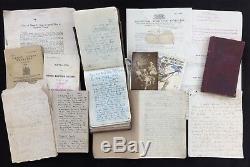WWI Military Archive, Spying Notes in Syria, Camel Corps in Palestine, Gallipoli


Major Albert John Wadman A. A fascinating archive of manuscript and printed material, the vast majority from his service during or just after the First World War. Included in the archive are. A Field Message Book containing 16pp of carbon-copy messages dated between September 10th 1915 and January 26th 1916, whilst 2nd Lieut. Of the Pack Mule Corps, Army Service Corps, many entries from the 9th Corps Transport Depot at Suvla (Gallipoli). With two hand written notes from Capt Phillips of 87th Brigade to Wadman regarding the return of pack ropes. An Army Book 152 (completely filled) containing 52pp of carbon-copy messages dated between November 10th and November 26th 1917 whilst (now) Captain Wadman was serving with the Camel Transport Corps 52nd Division (D Company) in Palestine.
The copy messages, all of which were marked Secret, were written during a period of heightened military activity whilst pushing towards Jerusalem, and sent to H. To give an idea of the general military activity taking place as well as the health/casualities of the men and camels. The book starts with them six miles south-west of El Hesi and with the camels in a poor state, fighting starts soon after (12.11) whilst near to Esdud It is extraordinary how well camels have stood the strain too far. The following day (13.11) states 2000 prisoners being taken in recent actions, and notes their movement towards Beshshit, with other sections moving to Mansura and Shahma, it also notes the first camel death.
Wadman reports that recent actions have seen the taking of Katra and Mughar, the Jaffa - Jerusalem line has been cut, and Ramle was to be attacked that evening. A couple of days later they are ordered to move towards Berfilya, the camels (apart from in B section) were holding up well, and on the 18th Jaffa is in British hands, and the next day it is believed that the enemy is surrounded in the Jerusalem district.On the 20th, he notes that D Section were still at Best Likia, and reports the incredible work done by a 300 camel supply convoy which reached its destination despite terrible conditions and camels regularly falling over on virtually no rations. The condition of the camels was deteriorating, the water and food supply inadequate to keep working animals alive, and some of Wadmans camels going between 4 and 6 days without water. Wadman notes on the 23rd that they were only six and a half miles from Jerusalem and is in action with the enemy.
The following day (24.11) a very heavy engagement has been proceeding all day, 156 Brigade is holding Nabi Samwil under very severe shell fire, and more fighting continues for the next two days until they reach the Best Likia road near Anan. The text displays a number of headlined topics, and it is obvious that Wadman was keeping a close eye on both the local political activists (which he calls the New Movement), as well as Turkish and French intelligence activities - and the Syrians helping them. The subjects include: Turkish Agent -?A series of 12pp pencil notes (written to the reverse of British Army A Form for Messages and Signals), undated, though apparently contemporary to the notebook above. Similar in nature to the notebook, the intelligence entries seem to have a slightly more urgent nature about them - possibly having been written on the move as the handwriting seems rushed. There is now really as much hatred against the British as against the French.
All French Spies will be shot, also all British spies if possible. British agents have been warned and Z has been warned he may be murderedIt was resolved to fight France and if necessary to call in the aid of the Turks. Noel on Special Duty in Diarbekir Vilayat 23pp, a printing note at the end states S. Includes a printed memorandum page by Noel written at Diarbekir on June 10th 1919. A 3pp manuscript reply written by Wadman in regards to a newspaper article on The Arab Question & The Peace Conference. 1919 and written whilst in Syria, he takes the French to task and suggests the Americans could play a part in Syria and Iraq to stop a possible Bolshevik revolution.Camel Corps Training Provisional 1913, 74pp plus adverts, the definitive manual on how to look after your animal in the Camel Corps. Information on how to mount and dismount, commands, formations, saddling and care of your camel. Illustrated by charming line drawings.
Extracts from Corps Routine Orders Camel Transport Corps, 32pp, listing new regulations and orders up to May 1917, so printing would be shortly after. A small leather covered notebook kept by Wadman, various manuscript technical notes throughout which apparently relate to water irrigation? Included are 44pp of notes headed Levels taken on Sharabas Estate, belonging to Compagnie Agricole, which would seem to be around the Nile in Egypt.A balance of related ephemera including a WWI era postcard of three officers (possibly one being Wadman), printed War Office Telegrams (dated November 27th/28th 1915) giving war news, printed General Routine Orders from GHQ Egyptian Expeditionary Force dated May 11th 1917, 10th Division 3pp notes on the care of horses, two Christmas cards for 1918. The item "WWI Military Archive, Spying Notes in Syria, Camel Corps in Palestine, Gallipoli" is in sale since Wednesday, May 23, 2018. This item is in the category "Collectables\Militaria\World War I (1914-1918)\Documents/ Maps". The seller is "ephemeracity1" and is located in Dorset.
This item can be shipped worldwide.
- Country/ Organization: Great Britain
- Type: Documents & Maps
- Conflict: World War I (1914-1918)
- Service: Intelligence
- Era: 1914-1945

